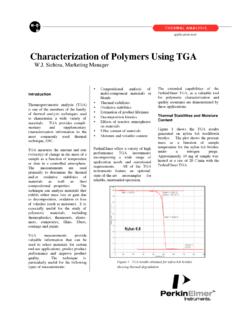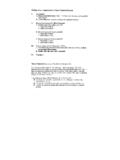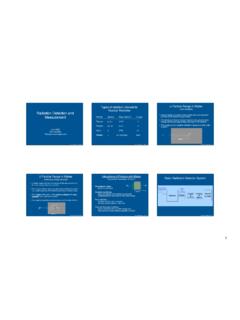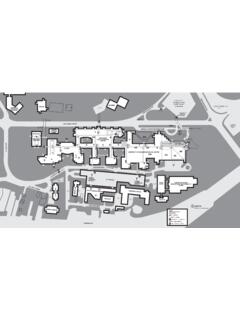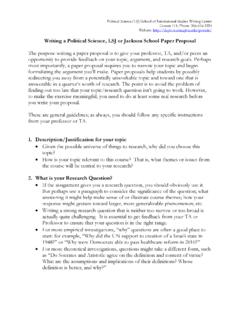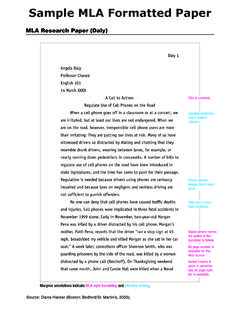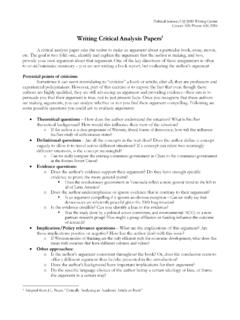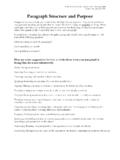Transcription of Phase Modulation - University of Washington
1 Phase Modulation Wei-Chih Wang Southern Taiwan University of Technology Interference When two or more optical waves are present simultaneously in the same region of space, the total wave function is the sum of the individual wave functions Interferometer Criteria for waveguide or fiber optic based interferometer: Single mode excitation polarization dependent Interference of two waves When two monochromatic waves of complex amplitudes U1(r) and U2(r) are superposed, the result is a monochromatic wave of the Same frequency and complex amplitude, U(r) = U1(r) + U2 (r). Let Intensity I1= |U1|2 and I2=| |U2|2 then the intensity of total waves is I=|U|2 = |U1+U2|2 = |U1|2 +|U2|2 + U1* U2 + U1U2 *. Interference of two waves Let U1 = I1 e j 1 and U2 = I2 e j 2 Then I= I1_+ I2 + 2(I1 I2) . Where = 2 1. Interferometers Mach-Zehnder Michelson Sagnac Interferometer Fabry-Perot Interferometer Interferometers is an optical instrument that splits a wave into two waves using a beam splitter and delays them by unequal distances, redirect them using mirrors, recombine them using another beam splitter and detect the intensity of their superposition Intensity sensitive to Phase change = 2 nd/.
2 Where n = index of refraction of medium wave travels = operating wavelength d = optical path length Intensity change with n, d and . The Phase change is converted into an intensity change using interferometric schemes (Mach-Zehnder, Michelson, Fabry-Perot or Sagnac forms). Mach-Zehnder Interferometer U2. mirror mirror U. U1. transmission Beam splitters Fiber-optic hydrophone (Mach-Zehnder Interferometer). Two arms Interferometer- Sensor and reference arms Mach-Zehnder interferometer Sensing fiber coil s Coupler k1 L= L1-L2. laser detector L1. detector L2. Coupler k2. Reference fiber coil r Mach-Zehnder interferometer Let output fields of the signal and reference arms to be, Er = Eo r k1k 2 cos( ot + r ). Es = Eo s (1 k1 )(1 k 2 ) cos( ot + s ). The output intensity of the interferometer: I =< Er2 > + < Es2 > +2 < Er Es >.
3 = I o [ r k1k 2 + s (1 k1 )(1 k 2 ). + 2 s r k1k 2 (1 k1 )(1 k 2 ) cos( r s )]. Where < > denote a time average over a period > 2 / . r, s are optical loss associate with reference and signal paths Mach-Zehnder interferometer Fringe visibility is given by, I max I min V=. I max + I min 2 s r k1k 2 (1 k1 )(1 k 2 ). =. r k1k 2 + s (1 k1 )(1 k 2 ). Polarization and coherence effects are ignored. Assumes Lorentzian line shape, self-coherence function ( ) =exp[ | |/ c] where is delay between tow arms, c is source coherence time, make < c -> ( ) 1. Mach-Zehnder interferometer Complementary output of the interferometer, I = I o [ r k1 (1 k 2 ) + s (1 k1 )k 2. + 2 s r k1k 2 (1 k1 )(1 k 2 ) cos( s r )]. The fringe visibility of the output: 2 s r k1k 2 (1 k1 )(1 k 2 ). V =. r k1 (1 k 2 ) + s (1 k1 )k 2. Mach-Zehnder interferometer Output intensities in simplified forms, I = I o ( A + B cos ).
4 I = I o (C B cos ). where r = s = . A = k1k 2 + (1 k1 )(1 k 2 ). B = 2 k1k 2 (1 k1 )(1 k 2 ). C = k1 (1 k 2 ) + (1 k1 )k 2. = r s Mach-Zehnder interferometer Let us assume differential Phase shift in interferometer is separated into of amplitude s and frequency and a slowly varying Phase shift d I o . I= (1 + cos( d + s sin t )). 2. I o . I = (1 cos( d + s sin t )). 2. Different current of these two output intensities is i = I o cos( d + s sin t ). Mach-Zehnder interferometer Quadrature point d = (2m + 1) / 2. Where signal is maximized due to the fact the operating Point is along the slope of the fringe Various configurations + Sensing fiber coil Coupler k1. (Push) laser detector L2 Coupler k2 detector Reference fiber coil + Sensing fiber coil Coupler k1. (Push-pull) laser detector L2 Coupler k2 detector - Sensing fiber coil + Sensing fiber coil laser Coupler k1.
5 (Push-push) detector L2 Coupler k2 detector + Sensing fiber coil Assignment What would be the output intensities and fringe visibility From both outputs? I = ( I o / 2) (1 + cos ). V=1. Michelson Interferometer Mirror U2 Beam splitter U1. Mirror U. reflection Michelson Interferometer Sensing fiber coil Coupler laser fiber L1. detector L= 2(L1-L2). L2. mirror mirror Reference fiber coil r Michelson Interferometer Differences between Michelson and Mach-Zehnder: 1. Single fiber coupler. 2. Pass through reference and signal fibers twice, Phase shift per unit length doubled. 3. Interrogated with only single fiber between source/detector and sensor. Fiber-optic hydrophone Fiber-optic hydrophone (Michelson Interferometer). Sagnac Interferometer mirror mirror U1. mirror U0 U2. Beam splitters U. Two direction reflection Sagnac Interferometric Fiber-Optic Gyroscope IFOG.
6 Interferometric fiber-optic gyroscope (IFOG). sin + sin = 2 sin( ( + ))cos( ( - )). Two counter propagating beams, (one clockwise, CW, and another counterclockwise, CCW) arising from the same source, propagate inside an interferometer along the same closed path. At the output of the interferometer the CW and CCW beams interfere to produce a fringe pattern which shifts if a rotation rate is applied along an axis perpendicular to the plane of the path of the beam. Thus, the CW and CCW beams experience a relative Phase difference which is proportional to the rotation rate. Consider a hypothetical interferometer, with a circular path of radius R as shown in fig. When the interferometer is stationary, the CW and CCW propagating beams recombine after a time period given by, where R is the radius of the closed path and c is the velocity of light.
7 But, if the interferometer is set into rotation with an angular velocity, rad/sec about an axis passing through the centre and normal to the plane of the interferometer, the beams re-encounter the beam splitter at different times. The CW propagating beam traverses a path length slightly greater (by s) than 2 R to complete one round trip. The CCW propagating beam traverses a path length slightly lesser than 2 R in one round trip. If the time taken for CW and CCW trips are designated as T+ and T-, then, The difference yields With the consideration that, c2 > > (R 2 ), The round trip optical path difference is given by and the Phase difference is given by If the closed path consists of many turns of fiber, is given by, where A = area of the enclosed loop, N = number of turns of fiber, each of radius R, and L = total length of the fiber.
8 As a general case, the Sagnac frequency shift is given by, Sagnac Interferometer if the loop rotates clockwise, by the time the beams traverse the loop the starting point will have moved and the clockwise beam will take a slightly longer time than the counterclockwise beam to come back to the starting point. This difference of time or Phase will result in a change of intensity at the output light beam propagating toward C2. If the entire loop arrangement rotates with an angular velocity , the Phase difference between the two beams is given by where N is the number of fiber turns in the loop A is the area enclosed by one turn (which need not be circular). 0 is the free space wavelength of light Minimum configuration of fiber- optic gyroscope Automobile Yaw Rate Sensor for Assessing the Intrusiveness of Secondary Tasks KVH autoGYRO fiberoptic gyroscope case study video Fabry-Perot Interferometer Interference of an infinite number of waves progressively smaller amplitude and equal Phase difference.
9 Fabry-Perot Interferometer ( R1 + R2 2 x R1 xR2 cos( )). I r ( ) =. 1 + R1 xR2 2 x R1 xR2 x cos( ). 2 2 y n = cos( ).. where cos( ) = 1 normal incident;. y = distance separation of mirror and fiber end;. n = index of refraction of the air gap;. = wavelength of the incoming He-Ne laser = nm;. R1 = intensity reflection coefficient of fiber;. R2 = intensity reflection coefficient of mirror;. Transmission Intensity T1T2. I r ( ) =. 1 + R1 xR2 2 x R1 xR2 x cos( ). 2 2 y n = cos( ).. where cos( ) = 1 normal incident;. y = distance separation of mirror and fiber end;. n = index of refraction of the air gap;. = wavelength of the incoming He-Ne laser = nm;. T1 = intensity transmission coefficient of fiber;. T2 = intensity transmission coefficient of mirror;. Finesse . 2 f =. 2. 4 R1 R2. f =. (1 R1 R2 ) 2. 2 Where = half power bandwidth f =.
10 This parameter is defined as the ratio of the half power bandwidth over the peak to peak full bandwidth. It's a way to measure the sharpness of the curve. Transmission Spectrum The frequency of each line is given by f = p Co/(2nycos ) where p = +1, +2, +3, . The lines are separated in frequencies by f = Co/(2nycos ). The spacing between etalon modes is = f 2/Co The mode number of the etalon is p = f/ f Film thickness Measurement This Phase change is important in the interference which occurs in thin films, the design of anti-reflection coatings, interference filters, and thin film mirrors. Interference Filters Thickness calculated from the interference condition: The passed wavelength is given by Anti-Reflection Coatings Multi-Layer Anti-Reflection Coatings Temperature Strain and Pressure Sensing 2 2 y n = cos( ).
